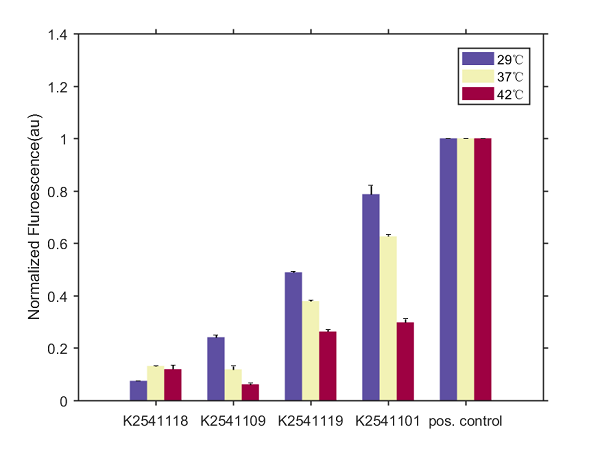Part:BBa_K2541118
Heat-repressible RNA-based thermosensor-18
A RNA-based thermosensor that can be used for temperature sensitive post-transcriptional regulation which is based on the change of RNA sencondary structure. The heat-repressible RNA-based thermosensors can repress translation of downstream genes at high temperatures.
1. Usage and Biology
RNA-based temperature sensing is common in bacteria that live in fluctuating environments. Most naturally occurring RNA-based thermosensors are heat-inducible, have long sequences, and function by sequestering the Shine–Dalgarno (SD) sequence in a stem-loop structure at low temperatures.
Here, we designed short, heat-repressible RNA-based thermosensors. These thermosensor sequences contain a single-strand RNase E cleavage (RC) site. RNase E is an enzyme native to Escherichia coli and many other organisms. Each heat-repressible RNA-based thermosensor sequence was inserted downstream of the transcription start site and upstream of the SD sequence. At high temperatures, the RNase E cleavage site (RC) is exposed, mRNA was cleaved by RNase E, and expression is ‘OFF’. At low temperatures, the RC binds to the anti-RNase E cleavage site (ARC) and forms a stem-loop. This structure sequesters the RC, and expression is ‘ON’.
These short, modular heat-repressible RNA-based thermosensors can be exploited as convenient on/off switches of gene expression.
2. Design
In order to design heat-repressible RNA-based thermosensores with different melting temperatures, intensity and sensitivity, we change the ARC sequence because the RC sequence is conserved. Three structural parameters come into consideration: stem length, loop size and mismatches or bulges in the stem.
Stem length is determined by ARC sequence. Adding stem length can optimize heat-repressible RNA-based thermosensors to higher temperature, while decreasing stem length has the opposite effect. The stem length is 6 base parings in K2541118. Loop size can moderate thermosensors melting temperature to an appropriate temperature. In K2541118, the loop sequence is AAAUAA. After designing, the theromsensor sequence is predicted by computational methods mFOLD to get its minimum free energy and secondary structure.
Figure 2. Design of synthetic heat-repressible RNA-based thermosensor. (A) The RNA secondary structure is predicted by mFOLD. (B) ARC sequence, loop sequence, the site of mismatch or bulge in the stem, ΔG and Tm are in the table.
3.Characterization
The thermosensor sequence is constructed on the pSB1C3 vector by GoldenGate assembly. The measurement device is composed of Anderson promoter (BBa_J23106), thermosensor (BBa_K2541118), sfGFP_optimism (BBa_K2541400) and double terminator (BBa_B0010 and BBa_B0012). We select a constitutive Anderson promoter J23106 as an appropriate promoter by pre-experiment. The sfGFP_optimism has faster folding speed and higher fluorescence intensity. The double terminator can reduce leakge (Figure 3). We characterized RNA-based thermosensors in E.coli DH5a.
K2541118, K2541109, K2541119 and K2541101 are four different heat-repressible RNA-based thermosensors. pos.control is positive control. The final normalized fluorescence was calculated as follows: normalized fluorescence = [(Fluorescence/Abs600)TS - (Fluorescence/Abs600)neg] / [(Fluorescence/Abs600)pos - (Fluorescence/Abs600)neg] ( TS = thermosensor, pos = positive control, and neg = BBa_J364007 ). As shown in figure 4, the fluorescence intensity of K2541118 decreases with elevated temperature.
Figure 4. Characteristics of synthetic heat-repressible RNA-based thermosensors. Each set of three bars represents the activity level of a different thermosensor. The bar colors purple, yellow and red represent the temperatures 29, 37 and 42°C, respectively. The height of the bars corresponds to the normalized fluorescence.
Figure 5. Experimental measurements of the collection of heat-repressible RNA-based thermosensors show a variety of responses. (A) Rows represent activity levels of different thermosensors. (B) Each set of three bars represents the activity level of a different thermosensor. The bar colors purple, yellow and red represent the temperatures 29, 37 and 42°C, respectively. The height of the bars corresponds to the normalized fluorescence.
4. Conclusion
Our data show that efficient RNA-based thermosensors with different melting temperatures, intensity and sensitivity can be built from a single small RNA stem-loop structure, thus providing useful SynRT toolkit for the regulation of gene expression.
Sequence and Features
- 10COMPATIBLE WITH RFC[10]
- 12COMPATIBLE WITH RFC[12]
- 21COMPATIBLE WITH RFC[21]
- 23COMPATIBLE WITH RFC[23]
- 25COMPATIBLE WITH RFC[25]
- 1000COMPATIBLE WITH RFC[1000]
| None |




